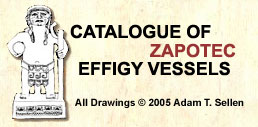| Key: AMNH 30.3/2301A |
| Actual Location: American Museum of Natural History, New York, United States |
| Collection: Ernest Erickson |
| Registration: 30.3/2301A and 30.3/2301B |
| Provenance: Unknown |
| Measurements: 38 x 29 cm. |
| Color: Grey clay with traces of white stucco. |
| Chronology: MA IIIB-IV (Eubanks 1999: 123); Peche 500 - 600 AD |
| Click to view Chronology |
| Reference: Boos 1968: 195, fig. 175; Eubanks 1999: 123-125, fig. 98; Bigelow Taylor 1988: 54, fig. 57 |
| Comments: Compare with the piece at the Amparo Museum (MAM 631) and the piece of the Paulson Collection (MES 23.8.240). According to a catalogue published by the AMNH there is another fragment of this urn consisting of two hands clasping a small pot (30.3/2301B). On the pot is the milpa glyph (see Bigelow Taylor 1988: 54, fig. 57). |
| Glyphs: Probably had a glyph C attached to its forehead. |
| Dating: TL by David Zimmerman, 1974, authentic. Information reported by Eubanks (1999: 124). |
|
